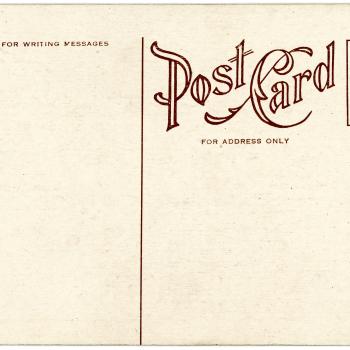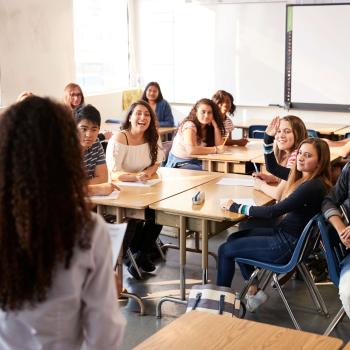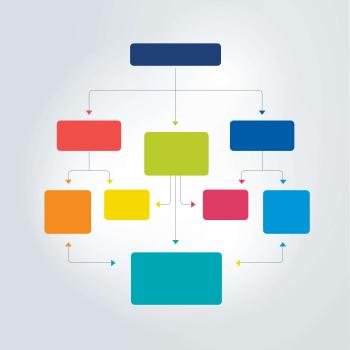This lesson provides a wealth of ideas for using notes in the classroom to promote authentic writing among children.

Note Writing in the Primary Classroom

Grades
|
Making Connections to Myth and Folktale: The Many Ways to Rainy Mountain
9 - 12
Lesson Plan
| Standard Lesson
Following the model of N. Scott Momaday's The Way To Rainy Mountain, students write three-voice narratives based on Kiowa folktales, an interview with an Elder, and personal connections to theme.

Grades
|
Choosing the Best Verb: An Active and Passive Voice Minilesson
9 - 12
Lesson Plan
| Minilesson
Students explore how active and passive voices are appropriate to different audiences. They examine online resources, and then draw conclusions about verb use, which they apply to their own writing.

Grades
|
Writing Acrostic Poems with Thematically Related Texts in the Content Areas
2 - 5
Lesson Plan
| Standard Lesson
Students read thematically related texts, scaffolded from simple to complex, to help them gather necessary concept vocabulary and background knowledge in a content area. They then write acrostic poems to organize and present their learning in a creative way.

Grades
|
Book Report Alternative: Creating Postcards for Fictional Settings
4 - 7
Lesson Plan
| Standard Lesson
In this alternative to the traditional book report, students report on their novel choices that feature journeys by creating postcards one of the settings featured in their books.

Grades
|
Style-Shifting: Examining and Using Formal and Informal Language Styles
9 - 12
Lesson Plan
| Standard Lesson
Students observe how language features vary when shifting from an informal to a formal style or vice versa. By engaging in style shifting in both speech and writing, students become aware of how we all change language styles depending on the contexts in which we are speaking or writing.

Grades
|
Analyzing First-Person Narration in Sharon Draper's Out of My Mind
5 - 8
Lesson Plan
| Standard Lesson
Students explore the different facets of complexity in the compelling first-person narrator in Sharon Draper's Out of My Mind.

Grades
|
Sharing Information about Careers with Infographics
6 - 9
Lesson Plan
| Standard Lesson
Students research careers of their own choosing. Then using Piktochart, students create their own infographics to illustrate their research.

Grades
|
Captioning the Civil Rights Movement: Reading the Images, Writing the Words
2 - 8
Lesson Plan
| Standard Lesson
Teachers guide students to carefully view images from the Civil Rights Movement and write captions that accurately describe the images and/or their probable purposes.

Grades
|
Highlighting Out-of-School Language Expertise with Pop Culture Dictionaries
6 - 12
Lesson Plan
| Standard Lesson
Students compose dictionary entries for words and phrases from pop culture texts (e.g., television shows, movies, lyrics, YouTube videos), connecting their definitions to their personal use of the terms.

Grades
|
"Three Stones Back": Using Informational Text to Enhance Understanding of Ball Don't Lie
8 - 11
Lesson Plan
| Standard Lesson
Students engage in a close reading of a passage from Matt de la Pena's novel Ball Don't Lie before researching important background information to assess the accuracy of the claims made by a character.

Grades
|
Understanding Irony
8 - 10
Lesson Plan
| Standard Lesson
This lesson enables students to define the three types of irony, identify and differentiate among examples of the types of irony, and demonstrate their understanding of each type.

Grades
|
A Picture IS Worth a Thousand Words: Using Infographics to Illustrate How-to Writing
7 - 10
Lesson Plan
| Standard Lesson
Students write step-by-step instructions on topics of their own choosing. Then using Piktochart, students create their own infographics to illustrate their instructions.

Grades
|
Picture This: Combining Infographics and Argumentative Writing
7 - 10
Lesson Plan
| Standard Lesson
After researching topics that the students have chosen, students write argumentative essays. Then, using Piktochart, students create their own infographics to illustrate their research.

Grades
|
Exploring Perspectives on Desegregation Using Brown Girl Dreaming
5 - 9
Lesson Plan
| Standard Lesson
Students read and discuss a selection of poems from Jacqueline Woodson's Brown Girl Dreaming to explore varying views on the process of desegregation in America.

Grades
|
Examining History with Maya Angelou's Poetry
6 - 8
Lesson Plan
| Standard Lesson
To understand the historical background that influenced Maya Angelou's poems, students research events to produce trading cards using the ReadWriteThink Trading Card Student Interactive. Through the sharing of these trading cards, students understand the historical background as they analyze Angelou's poetry.

Grades
|
"Blind Date with a Book": Creating Lifelong Readers
9 - 12
Lesson Plan
| Standard Lesson
This multi-lesson learning project encourages students to read engaging texts at their grade level and also works to promote habitual, independent reading in all students.

Grades
|
Huge Mistakes that Led to Catastrophe: Learning about Human-made Disasters throughout History
5 - 8
Lesson Plan
| Standard Lesson
After researching various human-made disasters such as the BP oil spill, the sinking of the Titanic, and the Great Chicago Fire, students share their research in oral presentations. Then students pair up to compare and contrast their disasters using the Venn Diagram Student Interactive or the Venn diagram Mobile App.

Grades
|
Picture This: Using Instagram to Report
4 - 8
Lesson Plan
| Standard Lesson
After taking a field trip that students document using mobile app Instagram, students become new reporters as they use the interactive Printing Press to tell about their experiences.

Grades
|
Aim for the Heart: Using Haiku to Identify Theme
7 - 12
Lesson Plan
| Standard Lesson
Using haiku, students focus on themes in literature and demonstrate their understanding of an author's message. Writing haiku to accompany an analytical paper hones analytical skills and fosters creative expression.